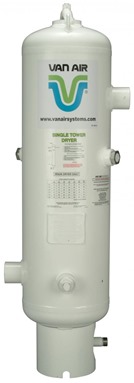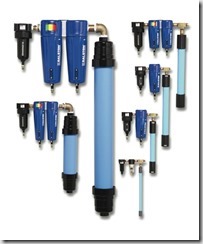We’re in the home stretch now discussing the final types of compressed air dryers. Previously we’ve discussed why compressed air dryers are needed in most industrial systems. We’ve reviewed refrigerated dryers and various types of regenerative dryers. That brings us to the final few types of compressed air dryers, the deliquescent and membrane type compressed air dryers. A note of importance: The dryers discussed in todays post are not normally associated with large industrial manufacturing plants.
Single Tower Dryers
Single tower dryers are used in more specialized applications and are available in 2 different types. Typically these are point-of-use applications such as moisture-sensitive pneumatic tools, valves or other equipment. Pressure dew points from single tower desiccant dryers are as low as -40°F. Since these types of dryers are not self-regenerative, the desiccant must be replaced, or regenerated outside of the dryer, according to the amount of usage.
Adsorbing Dryer
The single tower dryers that adsorbs water vapor with traditional desiccants (activated alumina) are capable of -40 degree F dew points. This type of dryer will stay on line until the desiccant reaches saturation at which point the desiccant is changed or the desiccant is removed and regenerated outside of the drying vessel. As you can imagine, the air flow is typically very low as the the single tower adsorbing dryer requires a great deal of maintenance.
Absorbing or Deliquescent
Single Tower
Deliquescent Type Dryer
The deliquescent dryer is most often the thought when single tower dryers are discussed. The deliquescent desiccant type dryer uses a hygroscopic desiccant material having a high affinity for water. The desiccant absorbs the water vapor and is dissolved in the liquid formed. These hygroscopic materials are blended with ingredients to control the pH of the effluent and to prevent corrosion, caking and channeling. The desiccant is consumed only when moist air is passing through the dryer.
Deliquescent dryers normally are designed to give a dew point depression from 20 degree F to 50 degree F at an inlet temperature or 100 degree F. This means that with air entering at 100 degree F and 100 PSIG, a leaving pressure dew point of 80 degree F to 50 degree F may be obtained (a reduction of 20 degree F to 50 degree F from the inlet pressure dew point). This type of dryer actually dries the air to a specific relative humidity rather than to a specific dew point. The deliquescent dryer can actually handle large flow rates up to 6000 SCFM @ 100 PSIG but require large amounts of desiccant material to maintain the desired dew point suppression making maintenance an even larger burden.
Advantages of Single Tower Deliquescent Desiccant Type Dryers include:
- Low initial capital and installation cost.
- Low pressure drop.
- No moving parts.
- Requires no electrical power.
- Can be installed outdoors.
- Can be used in hazardous, dirty or corrosive environments.
Disadvantages of Single Tower Deliquescent Type Dryers include:
- Limited suppression of dew point.
- Desiccant bed must be refilled, replaced or externally regenerated periodically.
- Drainage of dissolved solution (Absorbing).
- Regular periodic maintenance.
- Desiccant material can carry over into down-stream piping if there is no after-filter and if the dryer is not drained regularly. Certain desiccant materials may have a damaging effect on down- stream piping and equipment.
- Some desiccant materials may melt or fuse together at temperatures above 80°F.
Membrane Type Dryers
Membrane Type Dryers
Membrane technology has advanced considerably in recent years. The structure of the membrane is such that molecules of certain gases (such as oxygen) are able to pass through (permeate) a semi-permeable membrane faster than others (such as nitrogen) leaving a concentration of the desired gas (nitrogen) at the outlet of the generator.
When used as a dryer in a compressed air system, specially designed membranes allow water vapor (a gas) to pass through the membrane pores faster than the other gases (air) reducing the amount of water vapor in the air stream at the outlet of the membrane dryer, suppressing the dew point. The dew point achieved normally is 40 degree F but lower dew points to -40 degree F can be achieved at the expense of additional purge air loss.
Advantages of Membrane Type Dryers include:
- Low installation cost.
- Low operating cost.
- Can be installed outdoors.
- Can be used in hazardous atmospheres.
- No moving parts.
Disadvantages of the Membrane Type Dryers include:
- Limited to low capacity systems.
- High purge air loss (15 to 20%) to achieve required pressure dew points.
- Membrane may be fouled by oil or other contaminants (pre-filtration required).



